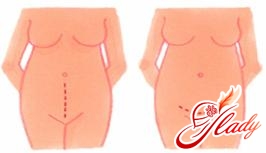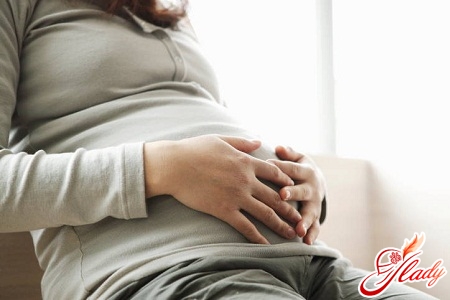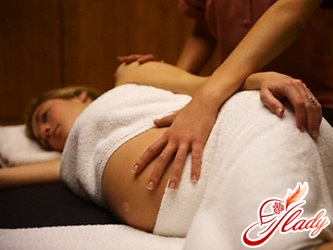 Caesarean section is a surgical operationиспользующаяся для извлечения ребенка через разрез в брюшной стенке и матке, если роды через естественные пути считаются слишком трудными или опасными для матери и/или ребенка. Впервые о кесаревом сечении упоминается у Плиния Старшего; существуют свидетельства, что кесарево сечение было известно в Древнем Египте и в Древней Индии, однако делали его редко, поскольку возможности медицины были весьма ограничены, а риск при таком хирургическом вмешательстве велик. В древние времена эту операцию делали в основном в случае смерти матери — чтобы спасти плод. В России кесарево сечение впервые было произведено в середине XVIII века. При кесаревом сечении (под общим наркозом или под эпидуральной анестезией) разрезается брюшная стенка, затем делается продольный разрез стенки матки, после чего плод и послед извлекаются из полости матки. Ваш врач может предупредить вас, что возможно вам понадобится операция кесарева сечения. Прежде всего, постарайтесь успокоиться и всесторонне обсудить эту проблему с врачом, собрать и изучить как можно больше информации по этому вопросу. Сегодня кесарево сечение почти также безопасно для матери, как и роды естественным путем, а при угрозе плоду — часто даже более безопасное для плода. Хотя кесарево сечение считается серьезной операцией, но риск, связанный с ней, сравнивается с риском при удалении миндалин или желчного пузыря. Каждый год тысячи детей, которые могли бы умереть или быть покалеченными в ходе естественных родов, рождаются здоровыми при кесаревом сечении. По сравнению с другими хирургическими операциями, оно весьма безопасно. Роды более удобные, быстрые и предсказуемые, чем через естественные пути. Сама операция обычно безболезненна, по-скольку выполняется под наркозом. Врач также получает более высокую оплату за кесарево сечение. Все это делает кесарево сечение привлекательным как для рожениц, так и для врачей. Более близкое рассмотрение, однако, выявляет крупные недостатки, из-за чего следует ограничить применение кесарева сечения случаями, когда роды через естественные пути небезопасны или невозможны. Кесарево сечение увеличивает риск серьезных проблем с анестезией, инфекцией и кровотечениями. Потребуется более долгая госпитализация. У вас появятся боли спустя недели после родов и трудности в уходе за новорожденным и остальными детьми. Вам потребуется больше обезболивающего, антибиотики и переливание крови более вероятны, чем после естественных родов. Не так скоро вы сможете вернуться к домашним обязанностям или на работу. Более того, финансовые расходы намного больше, чем при естественных родах. По мнению некоторых специалистов, дети, рожденные кесаревым сечением, имеют больше проблем с дыханием и поддержанием температуры, особенно если совсем не было схваток. Даже по сравнению с продолжительными или трудными родами через естественные пути этот дополнительный риск существует. Подобные заблуждения и нежелательные явления следует предупреждать с самого начала. Во-первых, следует осмыслить, что путь, каким ребенок появился на свет, никоим образом не влияет ни на мать, ни на ребенка; ни женщина не становится в меньшей степени матерью, ни ребенок не является в меньшей степени продуктом ее лона, если он появился на свет при помощи кесарева сечения. Во-вторых, важно, чтобы мать и ребенок проводили как можно больше времени вместе, начиная с самого рождения. В то же время не следует впадать в панику, если вы чувствуете себя слишком слабой для того, чтобы заботиться о своем ребенке, или если ваш ребенок требует интенсивного наблюдения новорожденных. Нет никаких оснований считать, что связь матери и ребенка завязывается только после рождения.
Caesarean section is a surgical operationиспользующаяся для извлечения ребенка через разрез в брюшной стенке и матке, если роды через естественные пути считаются слишком трудными или опасными для матери и/или ребенка. Впервые о кесаревом сечении упоминается у Плиния Старшего; существуют свидетельства, что кесарево сечение было известно в Древнем Египте и в Древней Индии, однако делали его редко, поскольку возможности медицины были весьма ограничены, а риск при таком хирургическом вмешательстве велик. В древние времена эту операцию делали в основном в случае смерти матери — чтобы спасти плод. В России кесарево сечение впервые было произведено в середине XVIII века. При кесаревом сечении (под общим наркозом или под эпидуральной анестезией) разрезается брюшная стенка, затем делается продольный разрез стенки матки, после чего плод и послед извлекаются из полости матки. Ваш врач может предупредить вас, что возможно вам понадобится операция кесарева сечения. Прежде всего, постарайтесь успокоиться и всесторонне обсудить эту проблему с врачом, собрать и изучить как можно больше информации по этому вопросу. Сегодня кесарево сечение почти также безопасно для матери, как и роды естественным путем, а при угрозе плоду — часто даже более безопасное для плода. Хотя кесарево сечение считается серьезной операцией, но риск, связанный с ней, сравнивается с риском при удалении миндалин или желчного пузыря. Каждый год тысячи детей, которые могли бы умереть или быть покалеченными в ходе естественных родов, рождаются здоровыми при кесаревом сечении. По сравнению с другими хирургическими операциями, оно весьма безопасно. Роды более удобные, быстрые и предсказуемые, чем через естественные пути. Сама операция обычно безболезненна, по-скольку выполняется под наркозом. Врач также получает более высокую оплату за кесарево сечение. Все это делает кесарево сечение привлекательным как для рожениц, так и для врачей. Более близкое рассмотрение, однако, выявляет крупные недостатки, из-за чего следует ограничить применение кесарева сечения случаями, когда роды через естественные пути небезопасны или невозможны. Кесарево сечение увеличивает риск серьезных проблем с анестезией, инфекцией и кровотечениями. Потребуется более долгая госпитализация. У вас появятся боли спустя недели после родов и трудности в уходе за новорожденным и остальными детьми. Вам потребуется больше обезболивающего, антибиотики и переливание крови более вероятны, чем после естественных родов. Не так скоро вы сможете вернуться к домашним обязанностям или на работу. Более того, финансовые расходы намного больше, чем при естественных родах. По мнению некоторых специалистов, дети, рожденные кесаревым сечением, имеют больше проблем с дыханием и поддержанием температуры, особенно если совсем не было схваток. Даже по сравнению с продолжительными или трудными родами через естественные пути этот дополнительный риск существует. Подобные заблуждения и нежелательные явления следует предупреждать с самого начала. Во-первых, следует осмыслить, что путь, каким ребенок появился на свет, никоим образом не влияет ни на мать, ни на ребенка; ни женщина не становится в меньшей степени матерью, ни ребенок не является в меньшей степени продуктом ее лона, если он появился на свет при помощи кесарева сечения. Во-вторых, важно, чтобы мать и ребенок проводили как можно больше времени вместе, начиная с самого рождения. В то же время не следует впадать в панику, если вы чувствуете себя слишком слабой для того, чтобы заботиться о своем ребенке, или если ваш ребенок требует интенсивного наблюдения новорожденных. Нет никаких оснований считать, что связь матери и ребенка завязывается только после рождения.  In some cases, based on certain indications, a decision about a cesarean section may be made in advance:
In some cases, based on certain indications, a decision about a cesarean section may be made in advance:
- Disproportionate pelvis and head(utero-fruit); (the fetal head is too large to pass through the mother's pelvis); This is indicated by the size of the child, determined by ultrasonographic research, or difficult previous births;
- Disease or other abnormalities of the fetus that cause risk or injury during self-delivery;
- End of previous pregnancy with caesareanas the cause of caesarean section continues to pose a threat (eg, a mother's disease or an abnormal pelvic structure) or if the uterus has been vertically dissected;
- High blood pressure or kidney disease of the mother: the mother may not be able to bear the birth stress;
- Incorrect position of the fetus, such as pelvic presentation (buttocks or feet forward) or transverse presentation, which can make independent birth difficult or even impossible.
There are also reasons that dictate a cesarean section long before birth:
- Diabetes maternal diabetes in the case when the termination of pregnancy is necessary before the term and the insufficient maturity of the cervix is confirmed;
- Infection of the viral type, available at the time of onset of labor; cesarean section is also done to prevent infection of the fetus during its passage through the birth canal;
- Placenta previa (when the child's place partially or completely blocks the opening of the cervix), which can cause bleeding if the baby's place begins to separate early;
- Early separation of the placenta - a clear separation of the placenta from the uterine wall, creating a great danger to the fetus.
Caesarean section is also indicated in cases whereurgent termination of labor is required, there is no time to intensify labor, or if the mother and/or fetus is considered unable to cope with the stress of labor. Other reasons may also arise:
- The state of pre-exclamptic disease or exlampsia, which does not respond to treatment;
- A delayed pregnancy (exceeding the term of labor for 2 or more weeks) leads to a worsening of the fetal conditions in the uterus;
- The emergence of a threat to the life of the fetus or the mother.
However, the decision on the need for a cesarean section is often made during the birth process. The following phenomena may be the reason for this:
- Lack of labor (cervixopens too slowly) after 16-18 hours from the beginning (some doctors wait even longer). Occasionally, oxytocin is also used to stimulate the spastic activity of the uterus before deciding on cesarean delivery;
- Fetal hazard phenomena noted during observation with special instruments or other tests;
- Abaissement of the umbilical cord: its compression can cut off the flow of oxygen to the fetus, causing a threat to his life;
- Unrecognized previous cases of placenta previa or premature abruptio sac - especially if there is a risk of bleeding.
Incisions of skin and uterus
During the operation, the doctor makes two incisions:The first incision is of the abdominal wall (skin, fat and connective tissue), the second is of the uterus. The abdominal muscles are not cut; they are spread apart, which allows them to heal more easily. Both incisions may be vertical or horizontal (transverse), or one may be vertical and the other horizontal. For example, the skin incision may be horizontal and the uterine incision vertical. It is important to know which uterine incision you had for subsequent births. This must be indicated in the medical history. There are two types of skin incisions for a cesarean section:
There are three types of uterine incisions:
When deciding whether to have a cesarean section,You and your doctor must weigh the risks and benefits. The risk of a cesarean section is worth it only in situations where vaginal delivery would pose an even greater risk to the mother or baby. Of course, you should trust your doctor that a cesarean section will not be made unless absolutely necessary. There are a number of issues to discuss beforehand.
- Are other methods of delivery possible beforea decision was made about caesarean section (excluding unexpected situations)? For example, the use of oxytocin to stimulate spasmodic activity or the use of standing position to increase activity attempts? True, it should be noted that in domestic clinics, alternative methods of delivery are rarely used.
- Is it possible before attempting to decide on operative labor (due to pelvic fetal presentation) to try to turn the head outwardly (to change the position of the fetus)?
- What kind of anesthesia can be used? When is general anesthesia applied? You can also use extradural anesthesia (to remain conscious) when the cesarean section is not done unexpectedly?
- During the passage of labor, the doctorthe uterus is low, in the lower part, so that there is a possibility of ending the next pregnancy in a natural way? You should also stipulate (because of cosmetic considerations) what a cut of the abdominal tissue will look like (which is usually not associated with the incision of the uterus).
- During the section (with or without consciousness), can your spouse or close relative be present?
- Can you or your partner keep the baby directly after birth and
- can you feed your child in the operating room? Will your partner be able to keep the baby if the operation is under general anesthesia? Can you be with the child in one room, if the child does not require special care? Will your relatives be able to stay at night to help you?
After cesarean section
The incisions will be sore for a few days.severe enough that you will need painkillers. You need to decide for yourself: what amount of painkillers is acceptable for you. You can take as little as possible, but if the pain interferes with your ability to care for your baby, it is wiser to take enough to feel comfortable. You can discuss this with your doctor, and it is better to listen to his advice. The first days after a cesarean section are especially difficult: turning over on your side, breathing, coughing - everything is difficult. Here are some simple tips that will make you feel more comfortable:
- Turn from back to back
Bend your knees so that your feet rest onthe plane on which you are lying. Press your feet into the ground and lift your hips so that your body is straight from your shoulders to your knees. Rotate your hips to the side and lower them. Then rotate your upper body to the same side. You are lying on your side. This way of turning saves your stitches from damage and prevents your elbows from painfully rubbing against the sheets.
- Cough
The cough is painful, but after general anesthesiaYou have to cough to get rid of the mucus that has accumulated in your lungs and can sometimes cause infection. Use the following technique: Reinforce your stitches with your hands, a small pillow, or a towel. Inhale deeply, filling your lungs completely. Exhale completely - forcefully and sharply, but gently - pulling in your stomach, not inflating it. Make a "woof" sound. Repeat several times over the course of an hour, especially if you feel gurgling or sobbing in your chest. If your chest is clear and you get out of bed regularly, there is no need to do this often. It is useful to try these techniques before surgery to get a feel for how it is done.
- Rise to the feet and walk
You will risk getting out of bed for the first time inseveral hours after surgery. A nurse or someone close to you will help you sit up, then stand up. When you first stand up, you may feel weak and dizzy. You can reduce dizziness by doing arm and leg exercises in bed to improve circulation. Take your time and let yourself get used to each new position as you move from a lying to a standing position. Here’s how to get out of bed: Turn on your side, let your legs hang over the edge of the bed, and move yourself into a sitting position. Sit for a while and move your legs. When you’re ready, lower your legs to the floor and stand up (with someone’s help). Stand as straight as you can. This won’t hurt your stitches, even if they feel like they’re stretching. Once you’ve gotten used to standing, take a small step. Each time you get out of bed, you’ll notice that it gets easier and easier. Try to gradually increase the length of your walks.
- Intestinal gases
Intestinal gases sometimes become realproblem after a cesarean section, as with any abdominal surgery. You will feel bloated and may have severe pain until you pass gas. Gas buildup is caused by the slowing of bowel activity as a result of the surgery. Moving back and forth in bed, breathing deeply, and rocking in a chair can help prevent or relieve gas buildup. Also try avoiding foods and drinks that cause gas. A nurse may give you a gas tube or enema to help pass gas if you are unable to do so on your own.
- Urination
Difficulty urinating may occurafter a ureteral catheter, anesthesia, and abdominal surgery. Your nurse will suggest ways to help you cope with this problem. If you are unable to urinate within a reasonable amount of time, the catheter may need to be reinserted.
- Lactation
It is possible and desirable to breastfeed aftercesarean section, but finding a comfortable position may be a challenge. To protect your stitches from the baby's weight and movements, place your baby next to you on a pillow or place a pillow over your stitches before picking up your baby for feeding. You may have a harder time recovering than women who gave birth vaginally. But give yourself time, the pain will soon pass. At first, you should have someone help you with baby care and household chores. But as soon as your physical condition allows, start postpartum exercises. Consult your doctor first.
Natural delivery after cesarean section
Most women who have had a cesarean sectionsection, can and should, for safety reasons, deliver vaginally in subsequent pregnancies. Current cesarean section surgeries almost always leave the uterus strong and healthy, with a well-healed scar. In fact, now that doctors and midwives have gained much experience with vaginal delivery after a previous cesarean section, they see little additional risk for most women. Their experience is consistent with numerous reports in the medical literature confirming the safety and benefits of vaginal delivery after cesarean section over repeat surgery. Among the benefits are lower maternal and infant mortality, no postoperative complications, shorter hospital stay, economic benefits, the ability to return to normal life sooner, and finally, psychological benefits. There are some situations in which vaginal delivery after cesarean section is impossible or unwise, such as cases in which the indications for surgery remain. If you have a chronic illness or a physical condition that makes a vaginal birth unsafe or impossible, you may want to consider another cesarean section. In most cases, however, the reasons for the first cesarean section do not recur. The most common indications for a first cesarean section - lack of progress, fetal distress, poor presentation or position of the fetus - rarely recur in subsequent pregnancies. With a high vertical (classic) incision, the risk of the scar coming apart during labor is slightly higher than with a low transverse incision. Most doctors only support a vaginal birth after a cesarean section if the incision is low transverse, although if a woman with a classic incision is informed of the risks but wants a vaginal birth, some doctors will support her wishes. Many professionals believe (comparing the risk of uterine rupture or repeat cesarean section) that vaginal delivery after cesarean section is a safer choice. We recommend reading:









